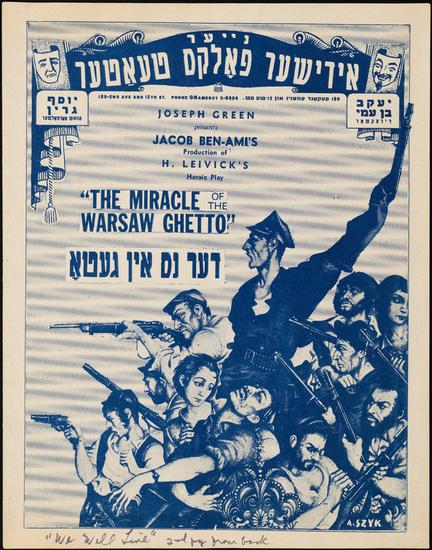MCNY Blog: New York Stories
Iconic photos of a changing city, and commentary on our Collections & Exhibitions from the crew at MCNY.org
From the Bowery to Broadway: Women of the Yiddish Stage
Last week, the Museum opened “New York’s Yiddish Theater: From the Bowery to Broadway,” a fabulous new exhibition that explores the history and influence of Yiddish theater in New York City. Continuing March’s theme of celebrating women in history, this week we take a brief look at a few of the beautiful, daring, complicated, and incredibly talented women from Yiddish theater.
![Unknown. [Stella Adler as Bessie Berger in "Awake and Sing!".] 1935. Museum of the City of New York. 62.97.272.](https://blog.mcny.org/wp-content/uploads/2016/03/62-97-272.jpg?w=329&h=410)
Unknown. [Stella Adler as Bessie Berger in Awake and Sing!.] 1935. Museum of the City of New York. 62.97.272.
The Group Theatre focused extensively on actor training utilizing techniques adapted from the Moscow Art Theatre, actor training that came to be known as the “Method,” and focuses on character development. In 1949, after a short stint in Hollywood, Stella founded her own school in New York, Stella Adler Studio of Acting, in 1949. Students included Elaine Stritch, Cloris Leachman, and Diana Ross, as well as some famous male actors.
![Unknown. [Sarah Adler's Novelty Theatre.] ca. 1912. Museum of the City of New York. F2012.63.495.](https://blog.mcny.org/wp-content/uploads/2016/03/f2012-63-495.jpg?w=229&h=300)
Unknown. [Sarah Adler’s Novelty Theatre.] ca. 1912. Museum of the City of New York. F2012.63.495.
Stella’s older half-sister, Celia, was also known for her portrayals of complex characters. Often called the “First Lady of the Yiddish theatre,” Celia grew up performing with her mother, Dinah. Early on, she considered a career as a teacher, but the encouragement of Yiddish and English stage star Bertha Kalich convinced her to stay with theater. She toured Europe and in New York acted with the influential Yiddish Art Theatre and Jewish Art Theatre.
![Unknown. [Celia Adler as Tsine in "Green Fields".] Museum of the City of New York. 66.35.8.](https://blog.mcny.org/wp-content/uploads/2016/03/mny264141.jpg?w=547)
Unknown. [Celia Adler as Tsine in Grine felder (Green Fields).] ca. 1919. Museum of the City of New York. 66.35.8.
One of Celia’s fellow actors in the Yiddish Art Theatre was Berta Gersten. Born in Poland, Berta emigrated to New York with her family as a child. To help support her family, she worked variously as a performer and in a factory. Her first serious role came in 1908 with a small part in Mirele Efros, “the Jewish Queen Lear.” One of the great roles for Yiddish actresses, Mirele is a powerful matriarch whose son and daughter-in-law usurp her control over the family business. Later, Berta played Mirele on stage and in a 1939 film version.
In 1944, Berta performed with the New Jewish Folk Theatre in Der nes in geto (The Miracle of the Warsaw Ghetto). One of the first plays to depict World War II while the war was still being fought, the plot relates true events involving Jewish resistance in Poland. Facing their demise in death camps, the residents of the ghetto rally and fight back. Berta played Esther, the wife of the rebellion’s leader. In Act I, she enters the scene smuggling firearms and ammunition in to the ghetto.

Souvenir program for Der nes in geto (The Miracle of the Warsaw Ghetto). 1944. Museum of the City of New York. F2012.63.585.
In her late fifties, Berta made her English-speaking Broadway debut in The Flowering Peach, a performance that was widely praised. She continued performing in English and Yiddish until just the year before her death in 1972.
![William Auerbach-Levy. [Menasha Skulnik and Berta Gersten in "The Flowering Peach".] 1955. Museum of the City of New York. 64.100.1481.](https://blog.mcny.org/wp-content/uploads/2016/03/64-100-1481.jpg?w=547&h=398)
William Auerbach-Levy. [Berta Gersten and Menasha Skulnik in The Flowering Peach.] 1955. Museum of the City of New York. 64.100.1481.
![Friedman-Abeles. ["Milk and Honey" theater still.] 1961-1963. Museum of the City of New York. 68.80.6721](https://blog.mcny.org/wp-content/uploads/2016/03/m3y13652.jpg?w=547&h=444)
Friedman-Abeles. [Milk and Honey theater still.] 1961-1963. Museum of the City of New York. 68.80.6721.
![Joseph Rumshinsky and Molly Picon. "I'll Always Be Yours" [Music for "The Circus Girl".] 1928. Museum of the City of New York. 69.134.6.](https://blog.mcny.org/wp-content/uploads/2016/03/69-134-6.jpg?w=257&h=342)
Joseph Rumshinsky and Molly Picon. “I’ll Always Be Yours” [Music for “The Circus Girl”.] 1928. Museum of the City of New York. 69.134.6.

Costume for Molly Picon in Dos tsirkus meydl. 1928. Museum of the City of New York. 69.134.30-32A-B.
It seems an injustice to try to cram the full lives of Molly, Berta, and the Adler women into a few paragraphs, and they are but a few of the amazing women that came out of the Yiddish theatrical tradition. I would be remiss not to mention Bertha Kalich, Vera Rozanko, Sophie Tucker, Fanny Brice, and the great Barbra Streisand. And I haven’t even gotten to the men–the beautiful, daring, and complicated men. For all these stories and more, come visit the Museum to see New York’s Yiddish Theater: From the Bowery to Broadway, on view through July 31st!



Pingback: From the Bowery to Broadway: Women of the Yiddish Stage | MCNY Blog: New York Stories | Rogues & Vagabonds
The exhibit was extremely well done. As a Yiddish speaker and a senior I was familiar with the Yiddish theater . I certainly will return a few more times to absorb all the wonderful material and comments.
May I suggest that a mention be made that the Folksbeiner has brought back “The Goldener Kale” a Yiddish operetta originally done in the 1920s. It will reopen at the Museum of Jewish Heritage, Battery Park in June 2016.I feel it would be a fine way to end the exhibit and show that the Yiddish Theater lives on.
Why is there no mention of the yiddish theatre orima donna Regina Prager?